02 Oct FAQs
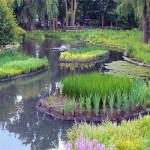
What is a BioHaven® Floating Island?
BioHaven floating islands are a new variant on constructed wetlands, or treatment wetlands. BioHaven Floating Islands “bio-mimic” mother nature’s own natural floating wetlands. When a BioHaven is launched, a whole diverse eco-system is created which soon attracts life in all its forms, from microbes to nymphs, to butterflies, to fish, birds…. all the way up the food chain. They can be custom created (see custom islands page) to virtually any size and shape, the largest of our islands (44,000 square feet) was launched in early 2010. Most recently, we have started manufacturing a mini line of floating islands for smaller ponds and container gardens in our Mokelumne Hill, California production facility. BioHaven floating islands are by far the most advanced constructed treatment islands on the market. Available in various sizes starting at around 5 square feet. Visit our Brand page to learn more.
What will grow on a BioHaven Floating Island?
If the water in your pond is well aerated, almost any plant suitable for your planting zone will grow on a BioHaven. If your water is not well aerated, or if you are not sure, we recommend riparian plants that are naturally adapted to low oxygen conditions. Many nurseries have wetland plants available. A list of sources for wetland plant seeds and wild flower seeds, which we also recommend, is available on request.

How long will it take for my BioHaven to mature into a beautiful floating island?
Your BioHaven floating garden should take no more than one season to mature. In fact, many experienced gardeners report that their floating islands develop faster than conventional gardens. The BioHaven floating islands in our pond also typically green up sooner in the spring and stay green longer in the fall due to the thermal effect of water.
Will ducks and geese or swans graze on my floating island’s plants? Will fish graze on plant roots that grow through the floating island?
This is something that constantly gets asked when purchasing a floating island. A carefully designed planting strategy for your floating island can either encourage or discourage grazing by waterfowl and root grazing by certain fish species; however, the floating island does also protect roots at the base, as well as throughout our proprietary bio matrix island design.
With thoughtful plant selection BioHaven floating islands can assist you in stewardship of your waterway. You can use your floating island to lure waterfowl away from other sites, or to feed fish.
BioHaven islands can also provide more secure nest sites for swans if you wish. It’s important to note that you can also select plants that are not conducive to waterfowl or fish.
We strongly suggest putting up a bird fence or netting your floating island to protect young plants during the initial growth stage. This is critical if you have swans, geese, or other waterfowl…they will more than likely have a feast on your young plants if the plants are not protected.
Can I purchase a developed BioHaven® floating treatment wetland so that I don’t have to wait for it to mature?
Some nurseries or our floating island distributors may have developed BioHaven floating treatment wetlands on hand and for sale.
You can also cover your floating island with sod, while still adding plants to the planting pockets. Sod is the quickest way for your floating island to look green; however, we would need to know if you plan to use sod so that we can adjust buoyancy in your floating island.
Please contact us for more information or to see how we can help.
Can I move a BioHaven® floating island from one pond to another? Are there other ways to adjust BioHaven floating wetlands to achieve the waterscape I’m after?
Small BioHaven floating islands, up to about 25 square feet, are easily moved. Pull them onto a tarp on a fairly level shoreline, let them drain for an hour or so, and then carry your floating island into the new location. If you are going to transport your wet floating island be sure to carefully cover the entire island to prevent plant desiccation. All of our floating islands come with anchor points, which also allow you to connect additional islands together…this is good for people looking for modular floating islands. Joiner cables can be used to attach an anchor to your island, but you can get creative and combine multiple islands to beautify your pond or aquascape.
Is it important or useful to anchor my BioHaven in one spot? If so, how are they anchored?
A disadvantage of leaving your BioHaven floating wetland island unanchored is that if your pond’s water level changes your island may hang up against a shoreline & this is not always practical. We have tried many different approaches in our own pond, a mini island was left unanchored and eventually rooted itself into the shoreline, over time, the plants started to spread and you wouldn’t be able to see where the island was…this could be good, but at the same time your island is no longer an island and a part of the shoreline. All islands come with anchor attachment points through which an anchor “rope” can be inserted.
Depending upon your floating island and the application, you can choose to go the simple route and simply tie a rope from your anchor point to a dock, or you can attach an anchor and cable to the floating island- dropping the anchor into the water.
It’s totally up to you and your need.
What do I do if a tree or some other large plant “volunteers” on my small BioHaven?
We recommend that you remove such plants from your floating island. Pruning them back aggressively should also work. On the other hand, a large BioHaven floating treatment wetland can support about two pounds of additional negative buoyancy per square foot. So in other words, a 500 square foot BioHaven floating treatment wetland can support up to 1000 pounds of weight, which might include people, picnic tables, or some other waterscape option. We often use rocks on BioHavens as habitat features. BioHaven floating islands can be made in any size, and can be customized to achieve higher levels of buoyancy if desired.
How does a BioHaven floating island improve water quality?
Many bodies of water associated with agriculture or septic systems or storm water management or lawn and garden fertilizers carry an unnaturally high nutrient load. This can result in a wide range of serious water quality problems. BioHavens represent a holistic way to “mine” these problem causing nutrients out of your waterway and convert them into a beautiful and wildlife enhancing floating island habitat. The secret is within our proprietary design – our BioHaven island matrix, this creates more microbes…more microbes = cleaner & healthier water.
Do BioHaven floating islands leach harmful substances such as Bisphenol-A into the water?
BioHavens are made from PET, which does not use BPA in its manufacture, and is not known to leach any other substances into water. It is the plastic used in most drink bottles and is safe around water. In fact, there is scientific evidence that BioHavens are net absorbers of BPA – in other words, they remove it from water. Visit our Case Studies page to view studies.
How can I eliminate algae from my pond, will a BioHaven floating island help with my algae problem?
Implementing a BioHaven floating island into your dirty pond will help with the overall quality and water clarity. While it will not completely eliminate algae, your floating island will help prevent algae from developing into a monoculture in your waterway. BioHaven floating islands create more microbes. The microbes feed off of the same food source that algae feeds off of – biohaven floating islands are like a housing unit for microbes and the more microbes in your pond, the more food they will eat – meaning that algae will eventually begin to starve.
Will a BioHaven floating island make my pond’s water clear?
BioHaven floating islands attract and bond suspended solids and colloidal into the island matrix where they will ultimately become soil and plants and beneficial microbes and gas. Some of these solids will also be sequestered into other life forms like damsel fly nymphs and fish. If you prefer to keep your BioHaven floating island functioning optimally as a biofilter the island can be removed from your pond and the matrix rinsed off, which will keep the BioHaven’s orifices open and able to collect more of the suspended solids and other fines that reduce your water clarity. This can be done as often as once every two months; however, it is not necessary.
What about the floating island buoyancy?
The buoyancy standard for BioHavens is 5 lbs per square foot, which equates to 55 lbs per square meter. This is the standard for our 8″ thick islands. We also make modules that are five feet by 8 feet by 10″s thick, which have a 12 lb per square foot buoyancy standard. Adding additional buoyancy is easy, but does reduce the biomediation quotient. In other words, there will be less surface area for microbial colonization as we add more buoyancy so more buoyancy equates to less pollution reduction.
If we constructed the entire floating island matrix with our specialty floatation mix, then a cubic foot of island would displace 64 lbs of water. The weight of the floatation mix is a designable number, but if it weighed four pounds and the floating island was 12 inches thick, then the island would offer 60 lbs of buoyancy per square foot of top surface. The floating islands can be made of any thickness, so accordingly there is no maximum….we can provide whatever buoyancy you require.
My city installed a BioHaven floating island in a retention pond near my home. It has done a great job of removing filamentous algae but there’s still duckweed and watermeal present. Will it remove these or do I need to use an herbicide such as Sonar? What impact would this have on the island and its vegetation?
The plants and especially the microbes that occur on a floating island, will seriously compete for nutrients with all of the other biota in your pond, including watermeal and duckweed. We do not know what impact a toxic chemical will have on either the island plants, or the microbes, that cause our floating islands to work. In fact, the buoyancy of floating islands, which is in part provided by the biogas produced by microbes, can be negatively impacted by some chemicals.
Perhaps the best option is to find a way to limit the nutrients getting into the water. Another option is to experiment with the chemical in question and closely watch the performance, particularly the buoyancy of your floating island. Another option is more floating islands…and the shade that they provide, as well as the additional competition for nutrients will help with overall water quality.
Another variable is to expand aeration of the water. In research that we have been exposed to, well aerated water will almost triple the nutrient uptake capability of our floating islands. Another option is to simply wait…over time the pond will develop a new balance. Perhaps over the next couple of seasons the islands can reduce the nutrient loading enough to favorably impact the volume of watermeal and duckweed.
Will a BioHaven floating treatment wetland ultimately grow and cover my entire pond?
Evidence from the wild, peat based floating islands we emulate indicates that while this is a possibility, it will take a long time. In some applications, like wetland restoration associated with Mississippi river delta, we hope to achieve high growth rates on very large floating islands. For most ponds however the quickest way to expand your floating island is to purchase another.
Must I inoculate my BioHaven floating island with beneficial microbes for it to work at improving water quality?
No, your BioHaven floating island or floating treatment wetland will attract beneficial microbes that are most likely already present within your waterway. Your BioHaven floating treatment wetland will also provide water quality benefits as it filters suspended solids and colloidals from the water. However, your floating island is likely to be even more effective at competing with algae if you do dose it with beneficial microbes, for which our distributors are sources. To inoculate a BioHaven floating island, simply drop one of our water soluble half pound bags adjacent to the island’s edge, ideally on the upstream or windward side of the island, so the microbes filter into the island.
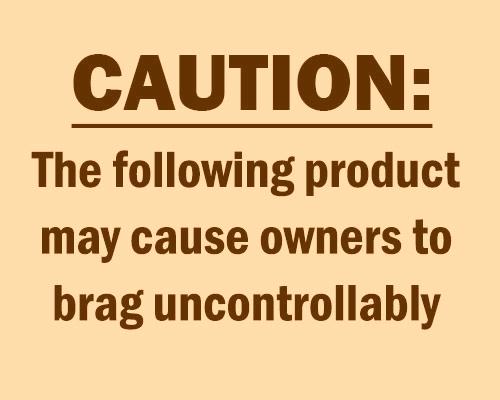
Are BioHaven floating islands safe to swim around or in high traffic areas?
Small BioHavens do not represent a safety issue that we know of. We recommend that larger islands, if in a heavy traffic area (boating), be clearly marked for visibility; though the islands do not represent a danger, we still encourage that every safety precaution be taken.
Unless your BioHaven floating island has been specially designed to support human activity, we recommend that you do not walk on it, or swim adjacent or underneath the floating island. As with any large floating object, use caution and do not swim under something that will potentially block your passage while trying to come up for air. Remember, BioHavens once planted will eventually have a substantial root growth under the island, use caution and do not swim under the island.
Do BioHaven floating islands attract mosquitoes?
No, they do just the opposite – BioHaven floating islands attract fish, nymphs, and other insects that actually consume mosquito larvae. Also, carnivorous plants that eat mosquitoes occur on wild floating islands and would no doubt be readily grown on these floating islands.
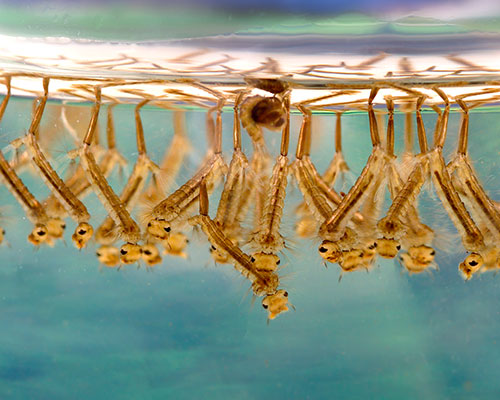
How long will a BioHaven floating treatment wetland / BioHaven floating island last?
If properly protected, your BioHaven floating treatment wetland should last indefinitely. The oldest BioHaven floating islands have gone through 15+ Montana winters and are doing just fine. Planted, your floating island will eventually look like a natural part of the environment…modeled after nature for nature.
PLASTIC LIFE:
Our island matrix is made from 100% Recycled PET Plastic. Plastic, as we know represents a challenge in waste management settings (as it doesn’t biodegrade like many other items that end up there), if protected from UV exposure, it will last indefinitely.
Our design for BioHaven Floating Islands takes advantage of this feature. A BioHaven is treated with UV protection at the time of manufacture, is non-toxic, and will not biodegrade.
GAS BUBBLE:
The BioHaven in effect “seeds” a natural system. As the growing cycle causes plants to mature, die off and leave their detritus; and as biofilm grows on and within the islands, giving rise to all kinds of life; this process of life releases gas as a by-product. This ensures the buoyancy of the BioHaven in the long term.
Off-gasing occurs within the island and contributes to buoyancy over time. These gases are what keep natural peat islands afloat.
Will a BioHaven floating island plug up?
We don’t believe so. Even if the floating island is accumulating solids and biofilm inside the biohaven matrix, it is constantly being “eaten” by fish and other small (or large) life forms. The heavier stuff will tend to slough off into the sediment below. This is unlike a constructed wetland, which will tend to plug up in due course.
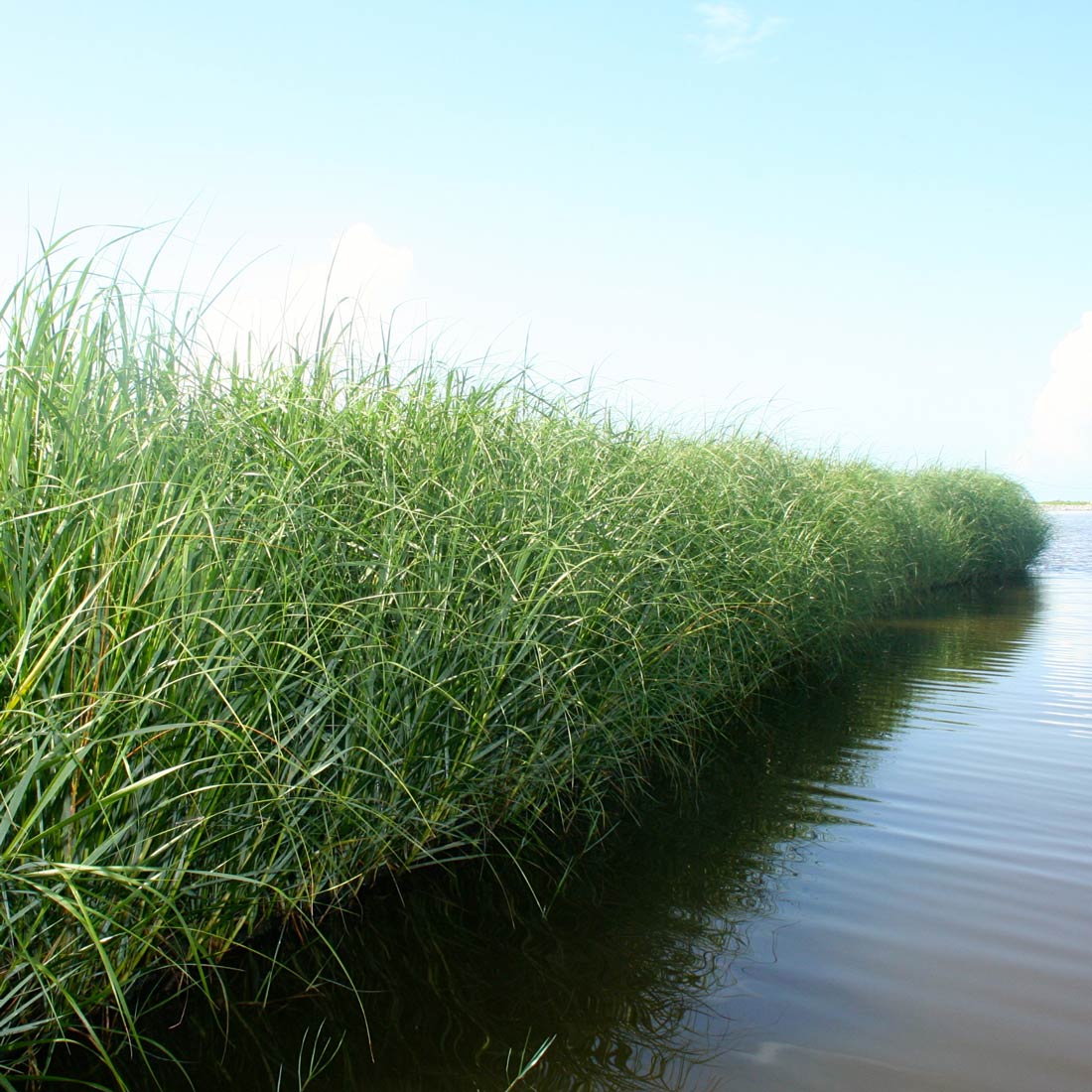
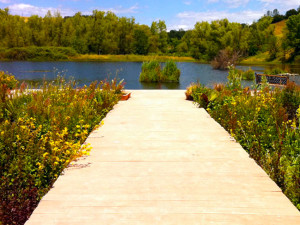
Can BioHaven floating islands be used as floating walkways?
Yes, but such a BioHaven would need to be customized to support the specified weight loads. BioHavens can also be used as green docks or piers when built specifically for such purposes. Stop by and visit our Mokelumne Hill facility, our dock is a BioHaven floating treatment living walkway…the dock serves our main purpose; however, you can design your own dock system using various platforms: wood, metal, plastic, etc. There are many options.
Will BioHaven floating islands flourish indoors?
Aquarium and rock garden scale BioHavens can survive indoors, BioHavens can provide an interesting new option in indoor settings. Appropriate full spectrum lighting is required for optimal performance. To view our smallest floating island option, visit the IPO 100 floating island page. Want more information on floating islands?


Can I launch and install a floating island myself, or do I need a professional to do it?
BioHavens are straightforward to launch, once the instructions are fully understood. There are also many advantages to getting trained help. All standard BioHaven models come with full instructions, and without any prior training, it is possible to successfully launch them. However, the more site variables there are (slope, limited access to water), the more you are likely to benefit from trained assistance.
• Once you get into the larger islands (130 sq ft and above) they require more people to assemble.
• Custom-built BioHavens will generally be best with professional installation. The advantage of getting a trained professional is the same as in any other field: peace of mind is assured and any problems are likely to be anticipated and solved more easily. Most of our large floating island distributors provide professional launching services, and they can advise with sizing, planting and placement of your BioHaven floating treatment wetland.
• Living Walkways and docks are always installed by professionals.
If you would like to be trained as a professional island launcher (an Island Master) please ask about the island masters program.
How long does it take to assemble and launch a 250 square foot island?
Two people can assemble, launch and plant a 250 in less than three hours. No real assembly is required for the 25 square foot and smaller islands.


Can BioHaven floating treatment wetlands help with removal of heavy metals or hazardous waste from a waterway?
Yes, BioHaven floating treatment wetlands (floating islands) can help to remove heavy metals or hazardous waste from waterways. A major study in New Zealand has shown that BioHaven floating treatment wetlands can remove 70-85% of total copper in 14 days and 30-45% of zinc in 14 days.
Other studies measuring their efficacy in this application are underway in Bozeman, Montana and Toronto, Canada. In addition, we have measured significant uptake of suspended solids, which is a form heavy metals occasionally take, from waterways.

Do I have to use a special planting mix?
You can decide what you would like to use, if any mix. We do generally advise to use a coir or natural mix that can wick water up while your plants are getting established. There is a specialized floating island planting mix that is designed to work with BioHaven floating islands. This floating island plant mix is known as WaterSoil and is an exclusive product of Floating Islands West.

How do I tend to the plants or weed my floating island?
In the event you want to weed your floating island – or tend your plants (for instance, to thin or prune them) – you can both wade out to your floating island and do it in place, or you can move the island onto shore. For the latter, it could make sense to tether the floating island to a point on the shore but alternatively you can use a pole (or similar) to gently pull a small island in.

How do I up-size my island?
You can either buy a bigger island, or join some smaller islands together with our specially designed cables and pins. BioHaven floating islands are available in sizes of up to 250 sq ft (and beyond for custom-built orders). The number of islands you can join together is limited only by the space you have available. If you want to start of with a small island and add on as time and budget allow, the square floating islands are a good choice to start a modular floating island. Let us know if you are interested in modular floating islands, we can always customize floating islands to your desired need.

Can I fertilize my floating island?
Although it is not needed, you can fertilize your floating island; however, if you do fertilize it, do so very, very carefully. In fact, it is usually best not to fertilize. After all, it is frequently nutrients, as in fertilizer, which cause water quality problems in the first place. One of the reasons native species are recommended is because they normally do not require much pampering.
If you must fertilize, use a product that is designed for the wet conditions associated with our hydroponic setting, our “wet” setting. Normal fertilizer can break down too quickly and burn island plants, where a specifically designed wetland fertilizer is designed to release slowly. For perspective, wetlands are actually bio-filters that incorporate large volumes of plant and microbial life, which typically compete aggressively, to sequester whatever nutrients filter through. Your BioHaven floating island is designed to function the same way, and keeping the floating island plant and microbial community hungry and searching for nutrients will result in a healthier waterway.

Can BioHavens remove pharmaceuticals from the water?
Early results from a student research project showed that BioHaven floating treatment wetlands can reduce levels of estrogen in water.
Increased levels of this chemical are entering our waterways through human use of birth-control pills resulting in fish populations becoming sterile. Other hazardous pharmaceuticals – such as chemotherapy drugs – get into our water and we greatly hope BioHavens can mediate against these too. There are plenty of research opportunities here…
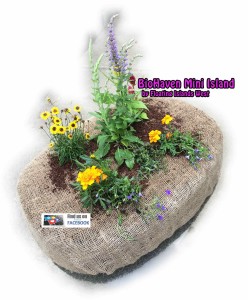
What comes in a BioHaven® Floating Island kit?
All floating islands will have anchor points on at least 2 sides. Instructions will be included with each island. If you do not receive instructions, please visit our planting and launching page for detailed instructions.
Your island order does not include planting mix unless you add it to your order.
Plants or seeds are not included; however, some of our distributors may be able to assist you with these needs.

Can BioHaven floating islands be used to grow herbs, veggies, or fruit?
Yes, BioHaven floating islands can grow edible plants. In fact, growing veggies, herbs or fruit on your own BioHaven floating garden can be a LOT of fun! You also have the option of growing some really exotic succulents like watercress or wild ginger. At the Shepherd research facility, tomatoes, raspberries, asparagus, watercress, wild ginger American Speedwell & Monkey Flower have been grown on BioHavens of various sizes. In California, we’ve grown tomatoes on some islands, as well as Monkey Flower, and we’ve done exceptionally well with Water Mint!

What time of year is best for launching a BioHaven floating island?
BioHaven floating islands can be launched any time of year. In fact, placing them in position on top of an ice covered waterway is a method we have tested with success. Another effective approach is fall seeding of islands which positions them for nice green up the following season. As you might expect, launching an island in the spring or summer means that your island can green up and add to your waterscape quickly. BioHaven floating islands have also been launched with a sod covering so they were immediately green, one example is in Canada where this was literally just a few days before ice up. All of these methods work. Incidentally, root growth on bluegrass sod covered islands, in a reasonably well aerated waterway, averaged slightly over one half inch per day during summer months. However, once the roots grew through the island thickness and were accessible by fish, the bluegrass sod roots were aggressively grazed & the bluegrass on the island flourished despite the grazing.
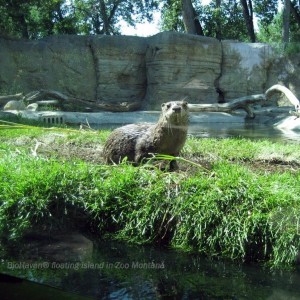
I have noticed that my BioHaven floating island will occasionally lean to one side or the other, why is this and what can I do to solve the problem?
On occasion, your BioHaven floating islands may lean to one side or the other. The potential causes of this are varied; for small islands, it may be as simple as having a frog jump on and off of the island (as reported by a proud owner of a 1 square foot island). For larger islands, a list may reflect the possibility that the plants or grasses on one side of the island have soaked up the water at a quicker rate than those on the opposite side. In the event that you have a leaning, the solution is quite simple. Below are a few ideas to help get it back in place…
- You can anchor the islands together with one of our custom pins (as was recommended for the small island and frog).
- Add a counterbalance such as a small piece of ornamental driftwood or a small decorative stone to the high side of the island
- In the case of an island with sod: Trimming some of the sod off of the low lying side of the island will help to reduce the uptake of water and thereby reduce the weight on that side.

I want a floating planter for my koi pond, why should I buy a BioHaven floating island?
BioHaven floating islands are SO MUCH BETTER than any other floating planter option on the market! Nothing quite compares to a genuine BioHaven floating island. You may have seen small flimsy planters for your koi pond, some market that the plant roots are “protected” – but what makes our floating planters (floating islands) so awesome is that you want the roots to go into the waterbody…the roots will become important for the fish and the full ecosystem. No worries though, because the islands are anywhere from 5′ – 8′ thick and have a webbed matrix – the roots are protected throughout that space where they are growing prior to entering the water. Our islands are able to support the weight of turtles, ducks, frogs, and more…it all depends on the size of the island. With a genuine BioHaven floating island, you will be sure to get a product trusted by the EPA and other government agencies. BioHaven floating islands have received recognition and even awards by some of the most respected agencies, they have been used by the Coastal Conservation & Shell Oil as well. Our mini islands are made with the same high quality standards that go into our larger islands.
In addition to the many water quality and habitat benefits that our floating islands have to offer, THEY LOOK PRETTY in koi ponds! So go ahead and try one…you’ll be happy you did and you might need this sign.

Has any research been done on the BioHaven Islands in brackish or marine settings?
-
In September of 2008, 700-plus square feet of BioHavens were launched in Alaskan sea water. They are monitored for the vegetation growth. Groups of engineers are working to measure nutrient uptake in brackish water, such as Cape Cod embayments and in Chesapeake Bay. Following is a letter for your viewing…
Marine Trials: Port Althorp and Elfin Cove, Alaska
Bruce & Anne,
I made it over to Althorp…Bob said that he was very impressed with how the dock held up. You will see some additional damage. One more section parted at the connectors. Bob said he witnessed some significant waves hitting the modules broadside. He said they easily rode up over the waves. He estimated 2 foot waves so that is a 4 foot sea. At one point he estimated 5 feet of snow on the modules and they were still above the water. He was impressed with the insulating potential. He said the snow remained on the modules much longer than he expected. This may provide some potential for walkways on tundra. There would be the flotation in the melt season along with insulation to protect the permafrost. We still have snow between the buildings. The plants on the module are just beginning to emerge. I did see some green poking through. I don’t know if you have a diagram of what you planted where but that would be helpful in the future.” Gordy Wrobel
-
SINGAPORE FLOATING ISLANDS focus on converting brackish inlet to fresh water – using BioHaven Floating Islands
A group in Singapore launched an archipelago of BioHaven floating islands as a way of introducing the public and the authorities to the potential of BioHavens as floating treatment wetlands. After the launch, the islands were inspected by the Health Minister. Their widespread application is being considered as part of Singapore’s “ABC” program for water (Active, Beautiful, Clean). We are involved in a significant floating island project as the country converts a brackish inlet to fresh water.
-
Most recently, BioHaven floating islands have been used along the coast of Louisiana by Citizens of Conservation and Shell Oil – BioHavens floating breakwaters have been used with great success receiving national attention.
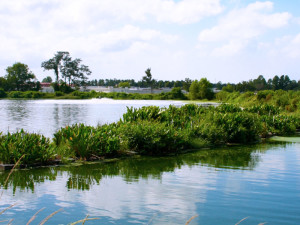
Have BioHaven floating islands been used in wastewater treatment?
Yes. One such project involving BioHaven floating treatment wetlands in Wastewater Treatment was performed by our friends at Martin Ecosystems. They were recognized by the EPA for their amazing work on using BioHaven Floating Treatment wetlands in a wastewater setting.
Gulf Guardian Winners (Martin Ecosystems BioHaven Application)
Baton Rouge, Louisiana
The BioHaven Floating Treatment Wetland (FTW) project at Elayn Hunt Correctional facility was done to determine how this new innovative water treatment tool could remove unwanted nutrients from wastewater prior to discharge to the environment. The BioHaven FTW accomplished this goal and in addition has helped the wastewater treatment facility to achieve and maintain compliance with their permit. In the five years prior to the implementation of this project and launching of the BioHaven FTWs into the wastewater system, the facility had an average of 10 non-compliance reports. Following the installation of the BioHaven FTWs non-compliance events have been reduced to one or less per year.
BioHaven FTWs also have demonstrated the ability to remove 74% of Chemical Oxygen Demand (COD), 35% of Ammonia, and 29% of Phosphate. Dissolved oxygen has also improved in the pond. Nutrient impact to downstream organisms and the environment has been greatly reduced.
BioHaven FTW Technology is designed around the same principles as a naturally occurring wetland. The man-made “floating islands” provide an optimal habitat for microbial and plant species. Similar to a wetland, the plants and microbes improve water quality. Unlike natural wetlands, they offer enhanced microbial growth by expanding available underwater surface area; i.e. microbial habitat. The result is a new and strategic means to achieve a concentrated wetland effect. Along with the nutrient removal processes, BioHaven FTWs also provide ancillary benefits for water treatment. They immediately increase retention time as the flow of water is “redirected” through or around the BioHaven FTWs and the physical embodiment of the BioHaven FTWs also physically traps solids within the water column.



Sorry, the comment form is closed at this time.